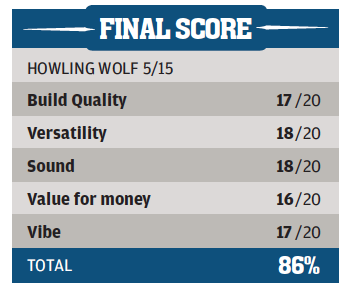Related Tags
Howling Wolf 5/15 Combo
A new name in amps is always welcome, and this British-built solid-state/valve hybrid combo takes a refreshingly different approach to getting boutique tones.
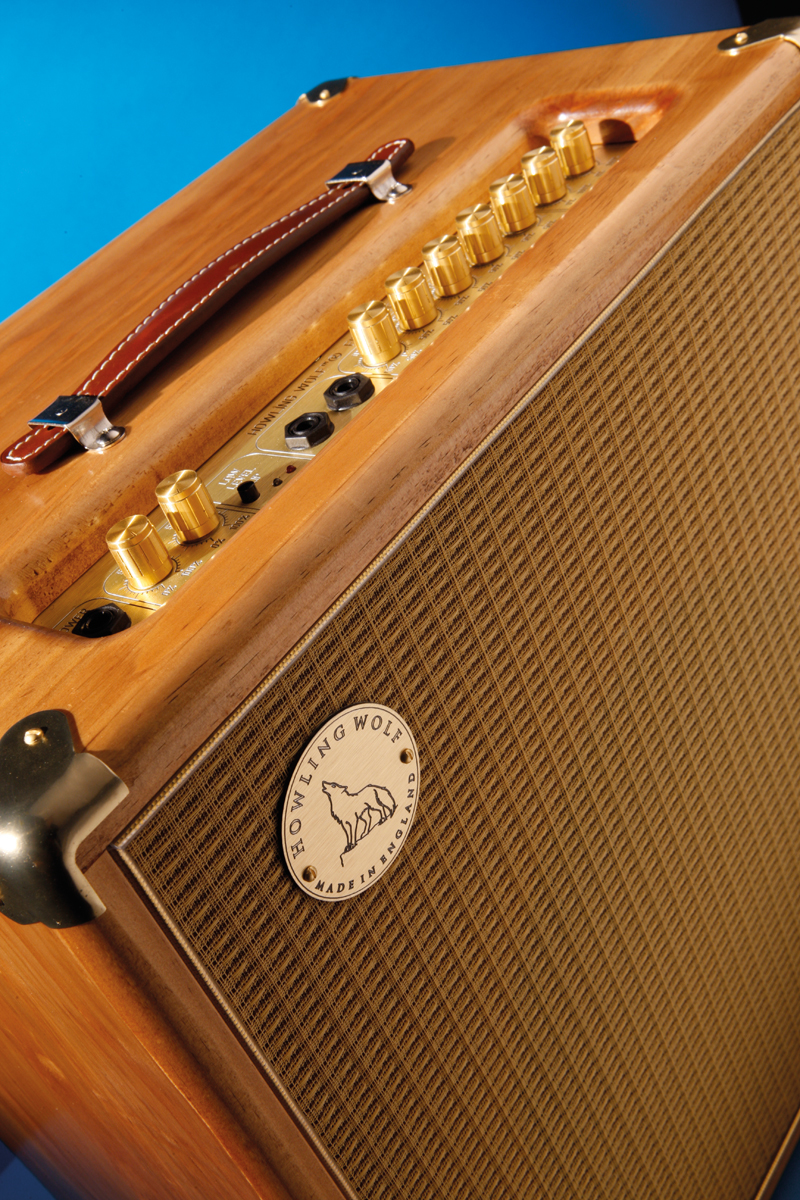
Details
Description: 5/15W solid-state/valve hybrid guitar combo amplifier with 2xEL84 power valves. Made in the UK
Price: £999
Contact: Howling Wolf – 07824 832884 – www.howlingwolf.co/home/4583403659
The last thing you’d associate with the name ‘Howling Wolf’ would probably be a small-scale guitar and bass amplifier manufacturer based in Worcestershire. Developed by EDC Ltd, the 5/15 amplifier has hybrid thermionic valve and semiconductor circuitry… but more of that in a minute, because the most striking feature is the lacquered wood open back cabinet.
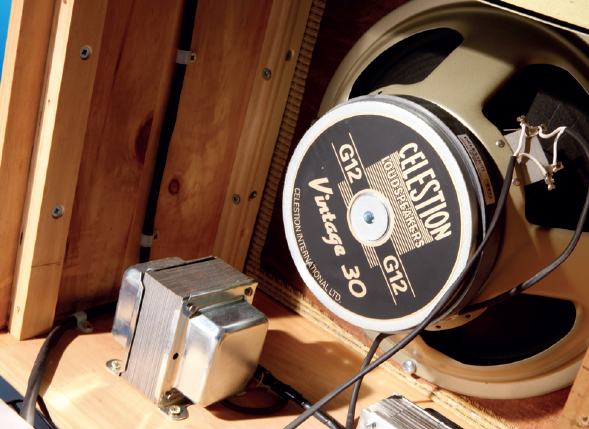 Customers can choose from standard pine or pay a little extra for tulipwood, white oak, red cherry and black walnut. The vulnerable corners are protected by metal covers, and we’re impressed by the tight dovetail joints. Gold banding provides a neat edge around the wheat-coloured grille cloth, with the gold ‘wolf’ badge and leather handle providing classy finishing touches. There’s no danger of the legending rubbing off, because everything is engraved into the gold brushed Treffolex control panel.
Customers can choose from standard pine or pay a little extra for tulipwood, white oak, red cherry and black walnut. The vulnerable corners are protected by metal covers, and we’re impressed by the tight dovetail joints. Gold banding provides a neat edge around the wheat-coloured grille cloth, with the gold ‘wolf’ badge and leather handle providing classy finishing touches. There’s no danger of the legending rubbing off, because everything is engraved into the gold brushed Treffolex control panel.
According to Howling Wolf’s Jonathan Miller, op-amps are far superior to valves for the 5/15’s preamp requirements. His rationale is that so many valves would be required to configure a five-band graphic equaliser that it wouldn’t be practical or cost-effective to use them. He also points out that valves were made a long time ago and that millions of pounds have been spent developing op-amps over recent years.
 Clipping diodes ar
Clipping diodes ar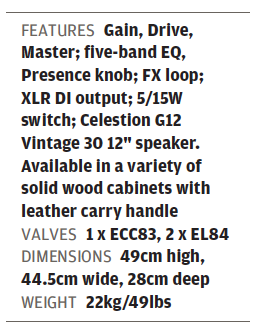 e employed to provide the overdrive and distortion, which is the method used in the vast majority of classic and contemporary overdrive pedals, often with great success. Despite the preference for a solid-state front end, valves are chosen for the splitter and power amp stages. Contrary to the information on the website, the splitter valve is an ECC83, and it drives a pair of EL84s into a Celestion G12 Vintage 30 speaker.
e employed to provide the overdrive and distortion, which is the method used in the vast majority of classic and contemporary overdrive pedals, often with great success. Despite the preference for a solid-state front end, valves are chosen for the splitter and power amp stages. Contrary to the information on the website, the splitter valve is an ECC83, and it drives a pair of EL84s into a Celestion G12 Vintage 30 speaker.
Gain and Drive knobs control the preamp section’s two stages and a Master control sets the overall output level. The 5/15’s signature feature is a five-band graphic EQ; measured in Hertz, the preset frequencies are 250, 500, 1K, 2K and 4K. Each band has a boost and cut knob, and a Presence boost control is provided for extra high-frequency shaping.

Input and output sockets for the FX loop are mounted on the top panel, and this will be particularly convenient if you like to place one or two line-level effects or a tape echo unit on top of your amp to be activated when required. As the name implies, the power output can be switched from 15W to 5W.
Sounds
The Gain and Drive controls produce different results. Gain, as the name suggests, provides crunchier and more contemporary rock tones, while Drive produces a rounder and more open overdrive which sounds smoother and feels as if it’s involving the power valves to a greater extent.
Of course, having the two allows you to explore a very wide range of clean, overdriven and distorted textures for blues, classic rock and even metal. Clean headroom and volume are also pretty much in line with what you might expect from an all-valve 15W amp, but some background noise is discernible at higher volume settings.
The low-level clip function is a bit of an oddity: it drops the volume level while increasing the gain to near fuzzbox proportions. You even get a slight upper-octave effect but the low frequencies retain a degree of clarity, suggesting that some of the lower frequency content is passing straight through without being overdriven.
The graphic is effective and allows you to make fine changes without giving the sound an unnatural or ‘coloured’ quality. Like the parametric EQ on a mixing desk, you may find it best to start with the controls in the zero position then use them to cut rather than boost the preset frequencies. The 500, 1K and 2K settings make it easy to coax full-throated
British as well as scooped US tones out of the 5/15, while the 4K control is well voiced for helping guitars to cut through mixes and the 250 control will beef up the twangiest guitar. The Presence knob is very powerful and it’s best used sparingly.
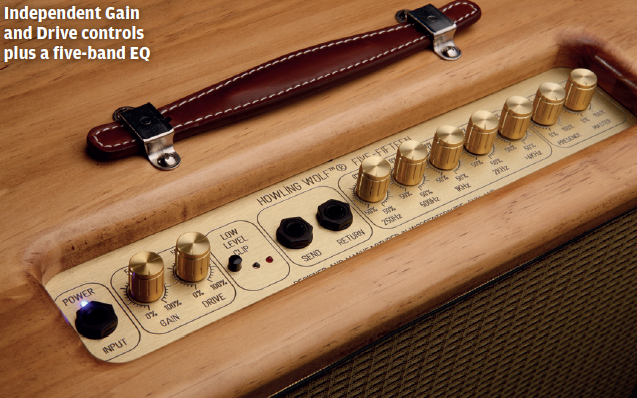 So does the solid-state preamp compromise the tone? We’d say it doesn’t – the 5/15 sounds and responds like a valve amp with plenty of dynamics and ability to clean up from the guitar volume. Many of us are content to get overdrive tones from pedals running into clean valve amps, so the 5/15 merely simplifies the process. Of course you can overdrive preamp valves, but the results often sound a lot grainier and fizzier than the Howling Wolf.
So does the solid-state preamp compromise the tone? We’d say it doesn’t – the 5/15 sounds and responds like a valve amp with plenty of dynamics and ability to clean up from the guitar volume. Many of us are content to get overdrive tones from pedals running into clean valve amps, so the 5/15 merely simplifies the process. Of course you can overdrive preamp valves, but the results often sound a lot grainier and fizzier than the Howling Wolf.
 Looking towards the other end of the signal chain, trying to replicate power valve overdrive using preamp valves makes no more sense than using diodes or cascaded transistors… in fact, they often sound worse. Restricting the use of valves to the splitter and power stages in hybrid amps makes far more sense; no wonder so many top players stayed loyal to their Music Man amps for so long.
Looking towards the other end of the signal chain, trying to replicate power valve overdrive using preamp valves makes no more sense than using diodes or cascaded transistors… in fact, they often sound worse. Restricting the use of valves to the splitter and power stages in hybrid amps makes far more sense; no wonder so many top players stayed loyal to their Music Man amps for so long.
Cranking up the 5/15’s Master will leave you in no doubt that there are valves on board, and they help to make this a toneful and juicy little amp that just makes you want to keep on playing.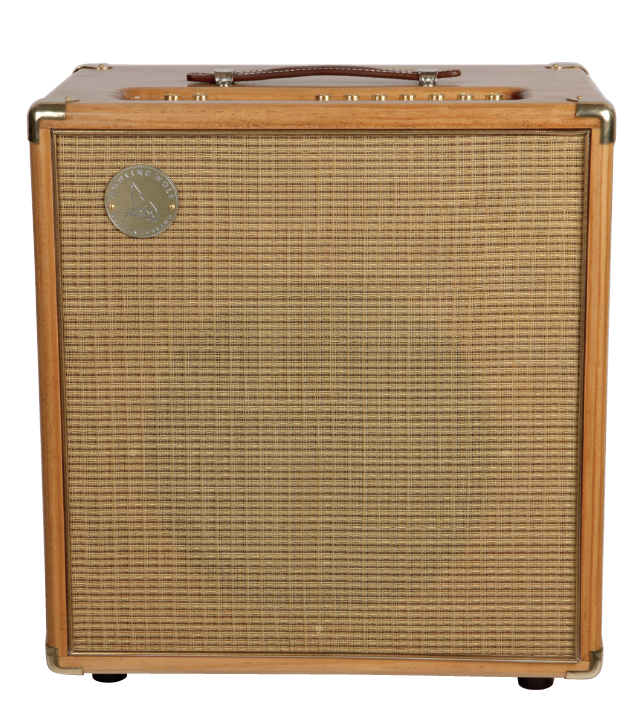 Verdict
Verdict
With precise frequency shaping the primary design consideration, the Howling Wolf 5/15 is a niche product. Depending on style and taste, some will appreciate the fine control while others will find it too complex. Ultimately the only thing that matters is the tone, and on that basis the 5/15 is absolutely deserving of your consideration.